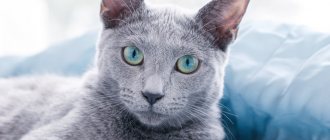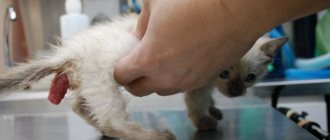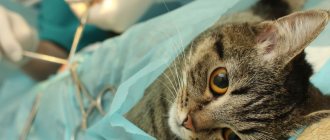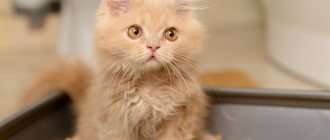Ringworm is one of the most common fungal diseases of cats. It mainly affects stray cats, but the fungus is easily transmitted to pets. The danger of trichophytosis is that people, especially the elderly and children, can become infected with it. The fungus is difficult to treat due to its high resistance to drugs. What symptoms can you use to identify trichophytosis and how to cure it?
Causes of infection
The causative agent of trichophytosis in cats is filamentous, unbranched fungi of the genus Trichophiton. Widely distributed in the environment. They are resistant to high temperatures and some disinfectants. Under favorable conditions (temperature, humidity) they retain the ability to infect for up to 17-19 months.
Important! Carriers of pathogenic trichophyte fungi are some types of wild animals, rodents, and stray animals (cats, dogs).
Trichophytosis affects cats regardless of breed and age. Infection occurs directly through contact. Fungal spores can be found in rooms where sick individuals were previously kept and are carried with fur.
At risk are small kittens, young animals under one year of age, weakened pets exhausted by viral-bacterial and parasitic diseases, as well as cats kept in groups in nurseries in unfavorable conditions.
Even if the pet does not walk on the street, or there are no other pets in the house or apartment, fungal spores can enter the house on the shoes, clothes of the owners, and household items.
Immunobiological preparations for lichen for cats
Such highly effective vaccines against lichen as “Vakderm-F”, “Polivak™”, “Microderm” have proven themselves to be excellent in veterinary practice.
"Vacderm-F"
- This veterinary product is made from inactive dermatophyte spores. Packaging is carried out in ampoules and bottles with a volume of 1-5 ml.
- Intended for vaccination of kittens starting from 2 months of age. The body’s immune response is finally formed 25-30 days after the first administration of the pharmaceutical.
- "Vakderm" is used not only as a vaccination against lichen, but also for medicinal purposes, because its use in complex therapy guarantees a complete cure for microsporia and trichophytosis.
- If the vaccine is used to treat ringworm, it is administered to animals 2-3 times in combination with the local use of antifungal ointments. In case of severe disease, the veterinarian will prescribe additional fungicidal medications.
If “Vakderm-F” is used as a vaccination against lichen, then injections of the pharmaceutical drug are performed intramuscularly (into the thigh) twice with a break of 10-14 days.
Dosage:
- kittens under 3 months of age - 0.5 cm³;
- adult animals are given 1.0 cm³ with each injection.
The animal body accepts Vakderm-F very well, due to which side effects occur in rare cases.
"Polivak™"
- The drug is a polyvaccine, which contains 8 different inactivated strains of fungi - Trichophyton, Microsporum canis, Microsporum ferrugineum, etc. The concentration of microconidia in 1.0 cm³ of one dose of the vaccine is approximately 20 million.
- Packaging is carried out either in ampoules or in glass bottles containing 1-2 parts of a light brown solution. The presence of a small sedimentary layer is acceptable. Before use, the bottle must be shaken several times so that the sediment is completely dissolved.
- "Polivak™" is used as an extremely effective vaccination against lichen and as a means to cure trichophytosis, dermatophytosis, and microsporia.
- If the polyvaccine is used for the purpose of prevention, then it is injected into the withers area or intramuscularly into the back of the thigh twice with an interval of 13-15 days. Depending on the age of the cat, the dosage varies in the range of one to one and a half cm³. Revaccination is carried out annually.
If Polivak™ is used to treat dermatomycosis, then two or three injections are performed with a break of 11-14 days. Measures of the drug are prescribed in volumes from 1.5 cm³ to 2.0 cm³.
The formation of immunity is completed on the 22-30th day after vaccination. The polyvaccine very rarely causes complications/side effects.
"Microderm"
- Includes antigens from the Microsporum camS VGNKI strain N 2293 and the Trichophyton mentagrophytes VGNKI strain N 27. It is characterized by high immunogenic activity and absolute harmlessness.
- Available in ampoules as a ready-made injection solution, as well as in the form of a freeze-dried homogeneous mixture in glass bottles.
Before use, the dry pharmaceutical preparation is diluted with saline solutions in the following proportions: for 1 dose (1.0 cm³) - 1 ml of solvent; The ampoule with liquid vaccine must be shaken until the sediment is completely dissolved.
"Microderm" is used for preventive immunization and treatment of dermatophytoses in a dosage calculated according to the age of the animals.
For the purpose of prevention, intramuscular injections of the vaccine are given in doses of 0.3 cm³ - 0.5 cm³. If the pharmaceutical drug is used in medical therapy, then the single dose varies from 0.5 cm³ to 1.0 cm³.
"Microderm" is administered twice with a break between injections of 10-15 days. If during treatment, symptom relief was achieved already at the first administration of the veterinary drug, then re-immunization is not carried out.
The vaccine is a safe product that does not cause side effects.
Prevention issues
General preventive measures are aimed at preventing contact of domestic animals with stray animals, as well as increasing the body’s resistance and immunity.
In second place is specific prevention - the use of vaccines:
- Trimivak,
- Polivac,
- Vakderm,
- Mentawak,
- Microderm.
All of them are a mixture of inactivated spores of trichophytosis and microsporia. It is injected twice with an interval of ten days, each time into the femoral muscle of different legs - first the left one, then the right one, or vice versa. Immunity to infection occurs approximately a month after the second injection and lasts about a year.
Important! When animals in the incubation period are vaccinated, clinical signs of ringworm develop. In this case, the vaccine is given two more times, but in therapeutic doses.
Adverse reactions to vaccination are rare:
- in some cases, a small compaction forms at the injection site, which soon goes away;
- There is a small category of pets that fall into a state of drowsiness after vaccination, but within 24 hours the animal returns to normal.
You can get rid of lichen once and for all, the main thing is to follow all the veterinarian’s instructions and strictly follow the instructions for using medications.
Author of the article: Marina Nikolaevna Chuprina, veterinarian, parasitologist
Useful video on how to treat skin diseases in cats
Ways of transmission of the disease
In most cases, the routes of transmission of the disease are scarce: it usually occurs through direct contact with a sick animal or surfaces with which the latter came into contact (millions of fungal spores remain on them).
- It often happens that a cat becomes infected simply by sitting in the place where his sick relative had been until that moment.
- There are frequent cases of infection through care items: on combs, carrying cages, baskets, etc., many infected hairs remain.
- The likelihood of infection increases sharply when animals are kept in crowded conditions. Because of this, breeders who adopt pets from cat shelters may risk their health.
Transmission from animal to animal
Thus, animal-to-animal transmission is most common. True, not in all cases we are talking about direct contacts: as we have already said, it is enough for the pet to simply sit in the same place where the sick cat was before.
Of course, infection does not occur in 100% of cases of contact with sick pets, but still the risk is really extremely high.
Transmission from cat to human
In principle, the disease is transmitted from cat to person in ways similar to those described above. Thus, children almost always become infected by playing with sick cats, i.e. transmission by direct contact is evident. Moreover, in many cases, parents also “join” them, since in the first stages of the disease one can easily not notice that something is wrong with the animal (it is not bald, there are no scabs and other characteristic symptoms).
Do kittens get infected and how to treat them?
Kittens, like adult animals, are susceptible to infection. Treatment in this case is provided only with local agents for 2–3 weeks. The earlier therapy is started, the higher the likelihood of a quick recovery. To treat kittens and pets whose weight does not exceed 2 kg, Furacilin solution is most often used, as well as antifungal drugs: Fungin, Sanoderm, etc. It is important to ensure that the kitten does not lick the medicine. To do this, you can put a special protective blanket on it. Before each application of antifungal ointment or cream, it is necessary to clean the lesion using a Furacilin solution (0.02%), which is easy to prepare yourself.
Furacilin has an antiseptic effect
If there are several animals in the house, the infection can easily spread. It is important to isolate pets from contact with each other and regularly carry out wet cleaning using chlorine-containing products.
Additionally, special shampoos that produce an antifungal effect are used to treat kittens. These include Imaverol, Lime Sulfer, etc. Such products are not cheap, but they allow you to get good results. These shampoos should be used once a week for 2 months. The kitten should first be rinsed with warm water (39 degrees). Then apply a little shampoo to the entire surface of the coat and lather. Leave for a few minutes and rinse with water. To prevent the kitten from catching a cold, you need to wrap it in a towel and close all the windows.
Symptoms and first signs of the disease
We list the main symptoms and first signs of trichophytosis:
- Accompanied by the development of skin lesions. As a rule, rounded, bald patches of skin appear on the skin of a sick cat. Subsequently, the skin in these areas becomes rougher and may become scaly. In rare cases, pustules may form. As a rule, the affected areas usually do not itch and do not cause any special problems for the animal. In most cases, the first affected areas appear on the cat's paws, stomach and face.
- The main symptom of many types of trichophytosis is loss of fur. In this case, the hairs not only fall out, but break off near the very root. If you look closely, you can see a kind of “hedgehog” of stumps of broken hair on the animal’s skin.
If the case is advanced, or the cat’s immunity is severely suppressed, patches of skin lesions can spread throughout the body of the sick pet. In this case, the skin either becomes very greasy or becomes covered with large scales, and the development of severe inflammation is also typical. Thus, a sick cat can become completely bald, its body is covered with scabs and ulcers, and a fatal outcome due to sepsis is possible.
Clinical signs
- Initial stage
. Formation of areas of redness and rash on the skin. Most often, this stage goes unnoticed due to the pet’s thick fur. You can pay attention to the strange behavior of the animal, attempts to scratch the area of redness in order to relieve the itching. - Hair loss stage
. At this stage, round hairless areas of skin covered with crusts and scales, localized in the head and limbs, can be clearly identified on the skin. The animal itches incessantly, which further spreads the pathogen throughout the body. The first lesion is usually single, only after a while new spots appear. - Formation of several foci
. In advanced stages, the fungus spreads to other areas and the cat develops several spots. - Fusion of foci
. In the absence of treatment, an expansion of the radius of the spots is observed, which merge with each other and form large bald spots.
The appearance of lichen in cats is often misinterpreted by owners as allergic hair loss or baldness of the cat. The disease cannot lead to the death of the pet, but it creates discomfort for both the owner and the cat.
Symptoms of trichophytosis
Trichophytosis is a type of ringworm. In the early stages of development of a dermatological disease, symptoms are barely noticeable. It is especially difficult to recognize the initial stage of the disease in long-haired individuals.
Important! The duration of the incubation period ranges from seven to ten days to one month. The intensity of manifestation and the speed of development of symptoms depends on resistance, physiological, individual characteristics of the organism, and age.
At the beginning of the disease, your pet may experience itching. On the skin in places where trichophyte fungi are localized, redness and a small rash are noticeable. A change in behavior and a slight increase in temperature are possible. Cats may show anxiety or, conversely, become depressed.
Symptoms:
- the appearance of hairless areas on the body;
- redness and thickening of the skin in the affected area;
- decreased activity;
- itching, anxiety;
- scratches on the body;
- gray-white scabs, dry crusts, dandruff, large red spots in the lesions.
With this disease, the inflammatory process initially affects the superficial layers of the epidermis, after which it moves into the deep layers of the dermis. The protective, barrier function of the skin is impaired. Fungi release endotoxins and poison the body of animals. Trichophytes often infect the claws of animals. If treatment is not started on time, the infectious process can cover the entire body of the pet.
Diagnosis of the disease
Standard diagnosis of the disease includes the use of three main methods:
- Wood's lamp. This is such a special source of ultraviolet radiation. It is believed that approximately 50% of parasitic fungi begin to fluoresce under UV radiation. That is, when the fur of a sick animal is irradiated, you can see a greenish sheen. But I would like to emphasize once again that the probability of successful diagnosis in this case is no more than 50%. Other parasitic species of fungi do not show any reaction to ultraviolet light.
- Microscopic examination of hairs and skin scrapings. However, this method is not without its positive and negative aspects. Its main advantage is simplicity. The main drawback is that a very highly qualified veterinary diagnostician is required, since otherwise he simply will not notice the dispute. And there is one more important nuance. When taking scrapings and wool samples, the material must be collected along the border of healthy and affected areas of the skin.
- The most accurate and high-quality diagnostic method is to grow pathogen cultures on special nutrient media. But there are a couple of drawbacks. Firstly, the method is not cheap. Secondly, it is long, since the crop can grow for almost two months.
Diagnostic methods
The external signs of trichophytosis are similar to a number of other fungal diseases that have different treatment methods, so it is important to undergo diagnostics at a veterinary hospital; take a stool test to determine worm infestation; check the level of leukocytes in the blood.
Diagnosis is carried out by three methods:
- Luminescent - irradiation of the affected area with a Wood's lamp. The presence of this disease is indicated by a green glow in the fur. The diagnosis is only 50% reliable.
- Microscopic - examine the scab particle under a microscope. Confirmation of infection is the presence of whitish threads of myxomycetes.
- Mycological is the most reliable and long-lasting method. A scraping is taken from the skin of the diseased individual and placed in a nutrient medium. The growth of the fungal colony is monitored for three months in order to determine its variety.
Contacting specialists is necessary because the disease is transmitted to people and is infectious in nature.
Main symptoms
The disease may not appear immediately after infection, but the fungus will definitely make itself known sooner or later.
The main signs of trichophytosis or microsporia in cats:
- The appearance of whitish skin flakes or dandruff in certain areas of the head or body.
- Hairless patches on the head, face, legs or back.
- Itching in the affected area.
- The claws peel off and turn brown.
- Ruffled fur.
- The appearance of suppuration on wounds where hair has fallen out (with prolonged absence of treatment).
- Sad looking pet.
Symptoms
At the initial stage of Trichophyton's growing season, a rash or skin hyperemia appears. The cat scratches itself, hairless spots appear on the head and neck, which gradually grow. The animal loses a significant part of its fur.
The papular form of the skin rash transforms into a pustular one. The blisters burst, the exudate dries out, forming scaly crusts, under which foci of suppuration form. Unlike Microsporum lesions, the inflamed surface does not itch. The cat's claws turn brown and become brittle.
Detection of Trichophyton is carried out in the following ways:
- Luminescent. Fragments of hairs fluoresce green when irradiated by Wood's Lama. The method detects no more than half of the number of people infected with Trichophytosis.
- Microscopic. Germinated micromycetes in the form of whitish nets are found on the crusts.
- Mycological. The pathological material is placed on a nutrient medium and the growth of Trichophyton colonies is observed. The method is informative, however, the wait for the result is a decade.
Treatment regimen for trichophytosis in cats
Our treatment regimen for trichophytosis in cats below is not ideal and should be “customized” to each specific situation. It should be taken into account that owners of several cats, one of which is sick with trichophytosis, will have to treat all of them at the same time.
Here are the main points of therapy:
- The animal is shorn, paying special attention to the hair on the affected areas of the skin.
- Bathing in a solution of Ivamerol is recommended. Take 20 ml of the drug per liter of water (the solution must be mixed thoroughly). The resulting mixture is poured into a bowl or mold of sufficient volume. The cat needs to be kept in the water for about five minutes.
- If you can’t buy Ivamerol, you can use Nizoral shampoo (for people, sold at any pharmacy). It also has a pronounced antifungal effect. This, by the way, is a very budget option, since Ivamerol costs much more.
- Irunin (based on intraconazole) has proven itself quite well. Take one capsule per adult animal. It is carefully cut, and the contents are mixed with 10 grams. a little melted butter. Feed the cat either forcefully, or additionally mix 1 gram with minced meat. per day (course of treatment 10 days). If you have experience in dosing, the medicine does not have to be mixed with anything. It is given in a dose of 10 mg per kilogram of live weight.
- Lesions on the skin after washing and drying are treated with Yam ointment three times a day. It must be remembered that the smell of this medicine is very specific, and the ointment itself is very soiled. A treated cat should not be allowed on beds and sofas.
- In severe cases, special antibiotics, griseofulvin, are prescribed. These are unique drugs, since no other antibiotic has any effect on parasitic fungi. The average dose is 18 mg per kilogram of body.
Treatment concept
It is immediately worth noting that all dermatophytoses, regardless of the type of pathogen (Trichophyton or Microsporium), are treated according to the same scheme, with the only difference being that the method will depend on the form of the disease. Therapeutic measures are primarily aimed at destroying the pathogen, and are also designed to alleviate the signs of the disease, in particular itching, and prevent the development of purulent dermatitis.
Important! Treatment of deprivation in cats at home is possible only after consulting a specialist!
Vaccination against lichen
Therapeutic vaccination
The most effective and fastest way to get rid of fungal infections of the skin and coat is to use a cat lichen vaccine. There are its varieties:
- vakderm,
- microderm,
- Polivac TM.
Injections are carried out intramuscularly two to three times with an interval between injections of 10-14 days. In principle, the use of immune drugs in therapeutic doses is quite sufficient for the animal to be cured. Already on the 15th day after the first injection, you can notice signs of recovery.
Vaccination against lichen is prohibited for pregnant or lactating cats, pets with elevated temperatures, as well as animals with non-contagious or infectious pathological processes.
Local treatment
In cases where the use of the vaccine is contraindicated, they resort to antifungal ointment, solution, and also bathe the animal with special anti-lichen shampoos intended for cats (sold in almost any veterinary pharmacy).
Topical treatment of ringworm in cats is of minor importance due to the large amount of hair. To increase the effectiveness of treatments, it is advisable to completely shave your pet, this is especially true for long-haired breeds. All hair must be burned after cutting!
Local processing is carried out:
- solutions of salicylic alcohol or iodine monochloride,
- antifungal liniments griseofulvin, miconazole, clotrimazole.
You should know it! It is not recommended to use ointments, gels or creams on a large area of the lesion.
In these cases, it is better to purchase an anti-lichen spray for cats - it is much more convenient to use and the fur will not be sticky and dirty from a greasy substance.
At least once a week, the surface of the body is completely treated with a solution intended for this purpose, for example, chlorhexidine, or bathed with shampoo.
You should know it! Solutions and ointments for lichen for cats can and should be used during the period of therapeutic vaccination. They are able to reduce itching and soften crusts, making them easier to remove from the surface of the body, and speed up the healing process.
Local treatment is appropriate for local lesions
Systemic therapy
In case of deep lesions, as well as in the development of purulent dermatitis, they resort to systemic treatment - tablets or injections of antibacterial and antifungal drugs are prescribed for a more effective effect on the pathogen.
Attention! Systemic therapy is contraindicated in pregnant cats. Some antifungal antibiotics cause serious allergic reactions, so monitoring by a veterinarian is required.
Unconventional approach
There are also folk remedies for the treatment of lichen in cats. What is not used as such:
- garlic solutions,
- starch,
- alcohol,
- vinegar,
- salt and soda,
- propolis,
- burnt paper,
- all kinds of mash based on fish oil and zinc powder,
- ash,
- iodine,
- celandine,
- tar and much more.
In principle, no one prohibits their use as a cure for lichen for cats, but will there be any result?
Important! Only celandine and tar are trusted in this list, and even then as an auxiliary, and not the main therapy. These are the remedies that have been used in folk medicine for hundreds of years to relieve skin diseases.
Tar is used to treat lichen
Vaccination against trichophytosis
Timely preventive vaccination will help protect your cat from becoming infected with lichen. The veterinary drug is selected individually by a specialist. The vaccine is administered to cats twice with an interval of 14-16 days. The vaccination schedule is selected by the veterinarian.
The following vaccines are used against the fungus:
- Polivac TM.
- Vakderm.
- Mikoderm.
Vaccination against trichophytosis is used by veterinarians not only for prevention, but also for the treatment of fungal infections in cats. In case of infection, the dose of veterinary medication is doubled.
Disease prevention
There is no ideal protection against trichophytosis, but still, preventing the disease helps to significantly reduce the risk of infection:
- Once every three months, revaccination is carried out with the Vakderm vaccine.
- The cat should not be allowed to come into contact with stray animals.
- It is necessary to carry out deratization in a timely manner, since rodents are also carriers of fungal spores.
- When visiting exhibitions, always use only personal animal care items and do not give them to anyone.
Prevention
In order not to look for an answer to how to treat ringworm in a cat, you should think about preventing its occurrence:
- Proper living and feeding conditions. Necessary for maintaining animal health and maintaining immunity.
- Vaccination. Vaccination will allow the animal’s body to more effectively fight the pathogen.
- Hygiene. It is necessary to regularly carry out wet cleaning using disinfectants. Avoid contact with yard animals.
Is ringworm transmitted to humans? Yes, it is transmitted, and it is extremely difficult to get rid of it. It is easier to prevent a disease than to treat the whole family for it.
Causes of trichophytosis
The most common carriers of this dangerous disease are rodents and stray animals. Also, spores of harmful fungi are perfectly preserved in the soil and on other surfaces. A favorable environment for them is damp and warm places. Spores can persist on the surface of the body or soil for several months until a favorable moment, and then successfully reproduce, penetrating deep into the skin or nail plate.
Domestic cats become infected from stray cats or after hunting rats and mice. Those pets who do not go outside and do not come into contact with stray cats are also at risk. The owner himself can bring a harmful infection into the house on the soles of his shoes. How to protect your beloved pet from disease? The first thing that veterinarians recommend is to closely monitor the health of your pet and, at the first manifestations of the disease, immediately seek help from a specialist.
Ringworm in cats - symptoms and treatment
Types of disease
- The fungus Trichophyton causes trichophytosis.
- Microsporum canis and Microsporum gypseum are the cause of microsporia.
- Ringworm in cats is almost the same for both types of fungi. Fungal spores can be found on an infected pet or in its habitat. Spores that fall from a cat's body pose a danger for the next two years.
- A damp and warm environment favors infection. The fungus remains on all objects with which the infected animal has come into contact: comb, bed, furniture and lost hair.
Methods of infection
There are many ways to become infected with ringworm.
- If a cat walks outside, the infection can be transmitted through contact with an infected animal. The fungus is transmitted through mice that animals hunt.
- Fungal spores are also transmitted by air. The smallest bacteria are carried into the house by the wind, along with clothes or shoes. Ringworm in cats also occurs through contact with owners whose pets are infected.
Rules for cleaning an apartment or house
Since trichophytosis is dangerous for humans, you need to follow the rules for cleaning an apartment or house:
- Firstly, when doing any work in an “infected” house, you must use disposable gloves.
- Secondly, it is advisable to treat all curtains and even walls with a steam generator. We also recommend using Clinafarm smoke bombs. They are specifically designed to combat mycoses. We remind you that after using them, your home will have to be thoroughly ventilated.
If possible, add the same Ivamerol to the water when washing floors daily. When this is not available, any chlorine bleach will do. The concentration must be selected so that the product does not spoil the floor covering (i.e., use the maximum permissible concentration).
Vacuuming should also be done daily. It is advisable to change dust bags at least once every three days, destroying them by burning. All accessible parts of the vacuum cleaner must then be washed with bleach.
General information
Trichophytosis is a fungal disease that appears mainly in animals, but can also spread to humans. The fungus spreads quickly due to a huge number of spores, while the infection remains on almost all surfaces where the infected cat has been. Despite this, not every pet can contract this disease.
Adult healthy pets that receive a full diet, have preventive vaccinations, are protected from trichophytosis. Basically, small representatives under 1 year of age are at risk. Cats or kittens who have recently suffered from a disease and their body is weakened. Also, if the animal is only kept indoors and does not receive proper care and nutrition, it can become infected with ringworm if it comes into contact with yard cats with a similar disease.
Carriers of the disease can be not only stray cats, but also dogs and most mouse-like rodents. Also, trichophytosis spores are highly resistant to various disinfectants, and are also not susceptible to exposure to various temperatures. Therefore, they can remain in the soil, on wooden and fabric objects for a long time.
Trichophytosis in a cat
How does otodectosis occur in cats?
Otodectosis in cats requires the help of specialists, since the mites that have settled in the animal’s ear begin to dry out the top layer of skin, which leads to the release of tissue fluid. Because of this, crusts begin to form, accompanied by severe itching, which causes discomfort in the pet, and he tries in every possible way to rip off this formation. If the animal succeeds, ulcers appear that are not protected from fungal and bacterial infections, which means that the pet’s health is in an even more dangerous situation, and to prevent this from happening, contact our clinic in Rostov-on-Don, where your animal will be provided with qualified help.
Treatment at home
There are times when it is not possible to contact a veterinarian and you have to carry out treatment yourself, trying old-fashioned methods. In ancient times, people solved such problems on their own. For this purpose, iodine and a mixture of vegetable oil and ash were used. All affected areas were treated with a disinfectant, in this case iodine. And the gruel with ash and iodine worked like a compress. Such procedures were carried out 5-7 times a day.
To prepare the ash, newspapers, currant or raspberry branches were used. The resulting ashes were mixed with any vegetable oil that was in the house. It should be a mushy mixture. This treatment is quite effective and completely safe for the health of your pet.
With any treatment method, it is recommended to remove hair from the affected areas. This is especially important for fluffy and long-haired cats. In some cases, it is recommended to completely shave the animal so as not to miss infected areas of skin with a red rash.
What do you need to know about the disease?
This disease is easily treatable if it is timely and correctly diagnosed. Our specialists in Rostov-on-Don will help you in this difficult situation, so don’t wait and bring your dog to us. The diagnosis is made based on examination of bald spots under ultraviolet light and scraping from the affected area. Only after all these procedures and microscopic examination can a diagnosis of trichophytosis in dogs be made with certainty.
The initial carriers of the disease are small rodents. Therefore, if you notice contact of your beloved dog with mice, rats, or other animals with suspicious spots on the skin, contact a veterinarian in Rostov-on-Don.
How to treat ringworm
Every owner of a “tailed friend” who is faced with an infection asks himself one question: how to treat ringworm? Ringworm is treated differently in long-haired and short-haired breeds.
- For kittens and cats with short hair, in which small areas are affected by the infection, anti-fungal ointments containing thiabendazole and miconazole are used for treatment. In addition to the fact that it has become clear how to treat ringworm, it is also necessary to prevent other diseases if the pet has them, and limit its contact with animals and people.
- Ringworm in long-haired cats may require trimming. Often, applying the ointment requires cutting off the affected area. When removing hair, it is important not to touch or irritate the skin, as this can spread the disease.
- Veterinarians, regardless of the breed of cat, advise completely cutting the animal during illness for faster treatment. The instruments are pre-sterilized and thrown away after cutting.
- Also, to the question “how to treat ringworm?” Lime sulfur dips, also known as sulfur baths, may be the answer. The smell is unpleasant and the fur may turn yellowish, but the treatment is effective.
- Sulfur baths can be replaced by a shampoo consisting of enilconazole and miconazole.
- Specialists prescribe oral medications only in cases where applying the ointment does not produce a visible effect after 2-3 weeks of treatment, or if the affected areas are extensive.
- Typically, oral ringworm is treated with Itraconazole and Greseofilvin.
Who is at risk?
Typically, domestic cats are rarely affected by this disease. More often you can find stray kittens with bald patches and obvious manifestations of the disease. But even a well-groomed pet can become infected. At risk are:
- Cats in poor health who are susceptible to various diseases. When fungal spores get on the skin, the immune system cannot cope with them. Immunity is weakened due to improper care and poor nutrition.
- Small kittens under the age of one year, whose body is not yet formed, and whose immunity is not able to cope with the fungus.
- Cats walking outside and coming into contact with sick animals.
People and animals that suffer from shingles are also at risk, since the disease is contagious. You can become infected by simply petting a sick pet. And the disease can manifest itself within a week to several months. Spores begin to spread if a person’s immune system is weakened and cannot cope with them.
If your pet gets shingles, you can protect yourself by taking the following precautions:
- Isolate the animal.
- Disinfect all pet items.
- Carry out wet cleaning and disinfection of the room in which the infected animal was located.
- Thoroughly wash and disinfect clothes and shoes that the person was wearing when in contact with the patient.
- Handle a sick animal only with gloves. After contact, be sure to wash your hands with a light alkaline solution.
- Do not allow children under 15 years of age to approach a sick animal.
Preventing your pet from becoming infected with fungal diseases
- Avoid contact with street animals.
- Complete balanced feeding.
- Regular tray change.
- Regular wet cleaning of the premises where the cat lives using disinfectants.
- Carrying out regular veterinary examinations and vaccinations.
- The use of vaccines as prophylaxis is currently controversial.
Read the article “Comb for cats: Which one to buy” –
If you liked this material, share it with your friends by clicking on the button on one of the social networks. You can also copy the direct link to the article.
Find out other useful information about pets on the Guardian of Purity portal. Stay with us!
Quantity










